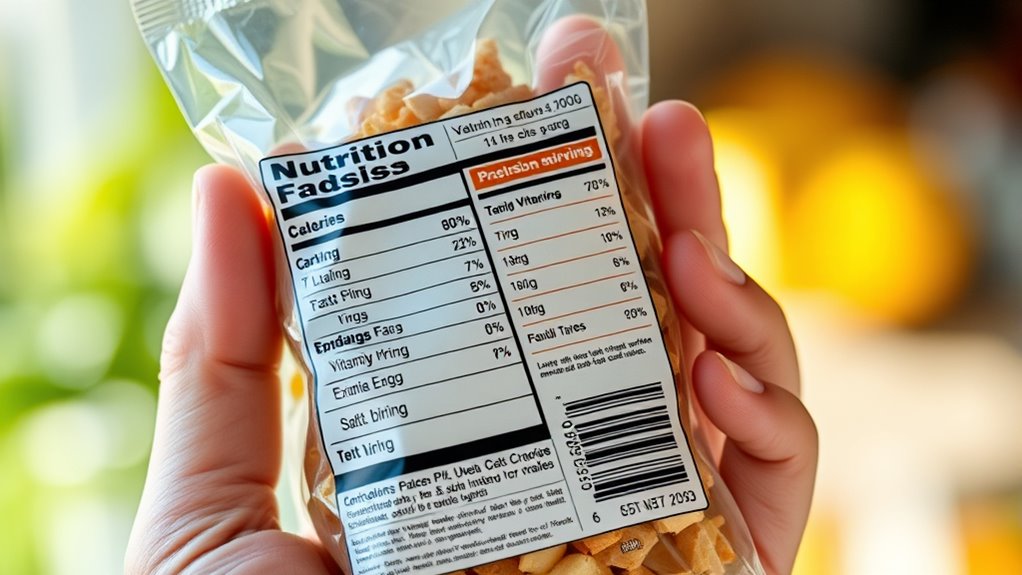Understanding nutrition labels helps you make healthier choices by showing ingredients, serving sizes, calorie content, and nutrients. Pay attention to serving sizes to manage portions and compare products effectively. Learn how to interpret calories, macronutrients, fiber, sugars, and Percent Daily Values to see what’s truly in your food. Watch out for misleading claims and marketing tricks. Keep these tips in mind, and you’ll have the tools to choose smarter foods every time you shop.
Key Takeaways
- Learn to identify key labels like serving size, calories, nutrients, and allergen information for better food choices.
- Understand Percent Daily Values (DV) to gauge nutrient richness and manage dietary goals effectively.
- Recognize organic certifications and ingredient lists to assess product quality and healthfulness.
- Use serving sizes to control portion intake and accurately track calories and nutrients.
- Be aware of marketing tricks and misleading claims to choose healthier, informed options.
What Are Nutrition Labels and Why Are They Important

Nutrition labels are tools that provide essential information about the contents of food products. They help you make informed choices by highlighting ingredient transparency, so you can see exactly what’s in your food. Accurate labels are vital because they guarantee the information you rely on matches the product inside the package. When labels are precise and clear, you’re better equipped to identify allergens, monitor your intake of specific nutrients, and avoid unwanted additives. This transparency builds trust and allows you to compare different products easily. Without accurate and transparent labels, you might unknowingly consume ingredients that don’t align with your dietary goals or health needs. In short, understanding these labels empowers you to choose foods that support your well-being.
Understanding Serving Sizes and Servings per Container

Understanding serving sizes and servings per container is essential because they directly influence how you interpret the nutritional information on a label. Your serving size is the standardized amount used for nutritional facts, while container servings tell you how many such servings are in the package. Visualize this by imagining a box of cereal with:
- A scoop that holds exactly one serving
- The label indicating 3 container servings
- A spoonful that matches the serving size
- The entire box containing multiple servings, each with its own nutrition info
Knowing the serving size helps you understand portion control, and knowing the container servings shows how many times you’ll need to multiply those numbers for the whole package. This clarity helps you make informed choices about what you’re eating. Additionally, understanding how juice cleanses function can help you better manage your nutritional intake during detox periods, and awareness of pinball machine weight can be useful if you’re setting up a gaming space in your home.
Calories and Why They Matter in Your Diet
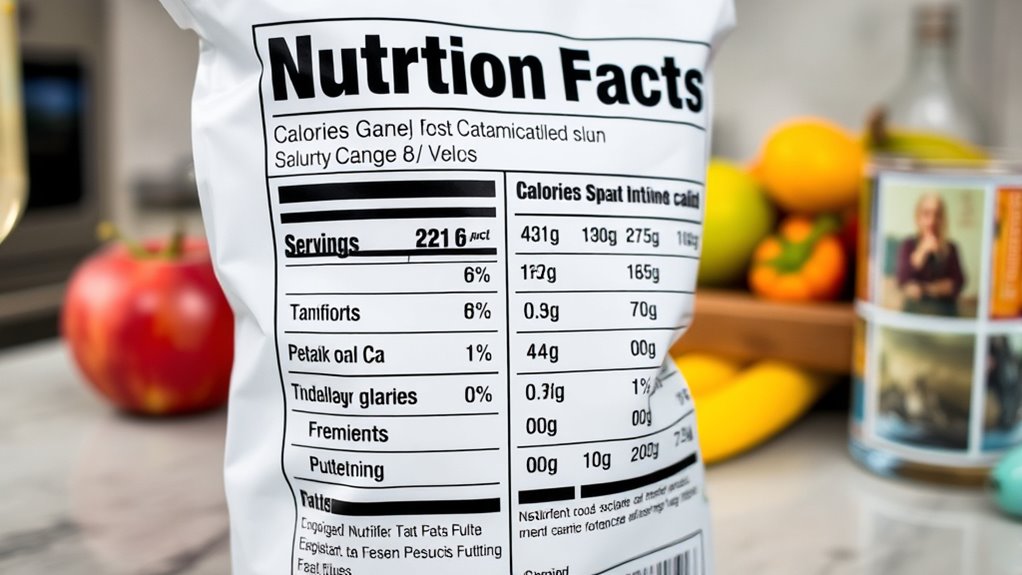
Knowing how many calories you consume helps you manage your energy levels and maintain a healthy weight. Your activity level influences how many calories you need each day, so balancing intake with activity is key. Understanding calorie basics makes it easier to make informed choices and stay on track with your diet goals. Additionally, being aware of calorie distribution across different food groups can further support balanced nutrition. Recognizing the importance of best anime movies can also inspire healthy habits by incorporating enjoyable and motivating activities into your routine.
Calorie Counting Basics
Calories are the energy your body needs to perform daily activities, from breathing to exercising. Tracking your intake helps with portion control and meal planning, ensuring you don’t eat more than your body needs. When counting calories, imagine:
- A small apple, providing a quick energy boost
- A handful of nuts, offering healthy fats and sustained energy
- A slice of pizza, high in calories but easy to overeat
- A glass of water, calorie-free and essential for hydration
Being mindful of portion sizes and balancing your meals helps manage calorie intake effectively. Knowing how many calories are in your food allows you to make smarter choices, stay within your goals, and maintain a healthy weight. It’s all about understanding what fuels your body best. Understanding calorie content helps you make better dietary decisions. Additionally, being aware of the calorie density of foods can guide you toward more nutritious options that support your health goals. Recognizing the energy balance between calories consumed and expended is crucial for weight management. Incorporating awareness of tableware and portion presentation can also influence serving sizes and help control intake. Paying attention to nutrient density can further enhance your diet by focusing on foods that provide more nutrients relative to their calorie count.
Energy and Physical Activity
Have you ever wondered how your body uses energy during different activities? When you move, your body burns calories—energy measured in calories—that fuel everything from simple tasks to intense workouts. Understanding energy helps you plan meal timing to support your activity levels and recovery. Proper hydration is essential because it maintains your energy production and keeps you performing at your best. Drinking water before, during, and after physical activity ensures your body stays efficient at converting food into usable energy. Keep in mind that consuming the right amount of calories for your activity level helps prevent fatigue and supports overall health. Energy expenditure can also be influenced by factors like body composition and metabolic rate, which vary from person to person. Additionally, understanding credit score and how it might impact your financial decisions can help you plan better for future needs. Managing your energy intake and staying hydrated are key components of maintaining optimal metabolic efficiency, leading to improved physical performance and overall well-being. By managing your energy intake and staying hydrated, you can optimize your physical performance and feel more energized throughout the day.
Daily Calorie Needs
Ever wondered how much energy your body needs each day to stay active and healthy? Your daily calorie needs vary based on age, gender, activity level, and goals. Knowing this helps you practice portion control and stick to effective meal planning. When you eat, imagine:
- Filling your plate with balanced portions of carbs, protein, and fats
- Choosing foods that fuel your workouts and daily tasks
- Avoiding overeating by understanding calorie content
- Adjusting intake as your activity level changes
- Recognizing that your metabolic rate influences how many calories you burn at rest and during activity. Additionally, understanding your calorie requirements can help you develop a personalized approach to nutrition and health. Your calorie needs can be estimated using various formulas that consider your personal factors, including your neural networks, which enhance predictive accuracy in health models, especially when analyzing complex data related to angel number soulmate patterns.
Macronutrients: Carbohydrates, Proteins, and Fats
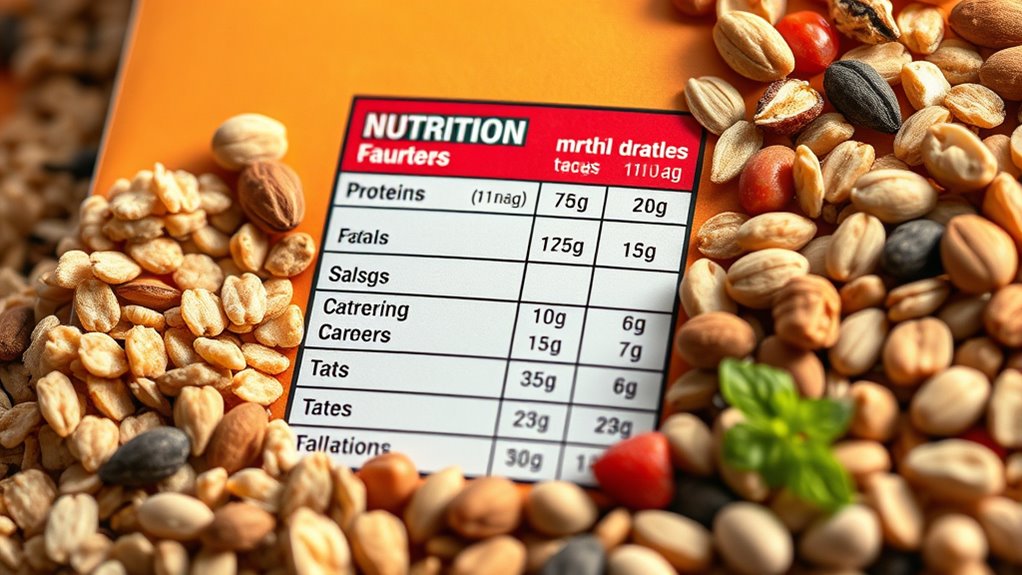
Macronutrients—carbohydrates, proteins, and fats—are the primary sources of energy your body needs to function properly. Carbohydrates are your body’s main fuel, supporting carbohydrate metabolism to produce quick energy. Proteins play a crucial role in protein synthesis, helping your body build and repair tissues, including muscles and enzymes. Fats provide long-lasting energy, support cell structure, and aid in absorbing fat-soluble vitamins. Understanding how these macronutrients work helps you make balanced food choices. For example, consuming enough protein ensures your body can efficiently perform protein synthesis, essential for recovery and growth. Recognizing the importance of mammography guidelines can influence your overall well-being and health choices. Additionally, maintaining proper intake of each macronutrient is vital for optimal health, ensuring your body functions at its best. By managing your intake of each, you support overall health and energy levels, optimizing your body’s function.
The Role of Dietary Fiber and Sugars

Understanding the amount of dietary fiber in your food helps you choose options that support digestion and overall health. Checking sugar content indicators on labels reveals how much added sugar you’re consuming, which can impact your energy levels and weight. Being mindful of both fiber and sugar can guide you toward healthier choices every day. Additionally, being aware of added sugars helps prevent overconsumption of refined sugars, promoting better metabolic health.
Dietary Fiber Benefits
Have you ever wondered how dietary fiber can improve your health? It plays a essential role in maintaining digestive health and supporting overall well-being. When you consume foods rich in fiber, like whole grains, you help keep your digestive system functioning smoothly. This can lead to less bloating, regularity, and reduced risk of digestive issues. Imagine:
- Softening your stool, making trips to the bathroom easier
- Slowing down digestion, helping you feel full longer
- Supporting the growth of good bacteria in your gut
- Stabilizing blood sugar levels after meals
Eating enough dietary fiber helps your body efficiently process food and prevents discomfort. Incorporating high-fiber foods into your diet is a simple, effective way to boost your health and keep your digestive system happy.
Sugar Content Indicators
While dietary fiber helps regulate blood sugar levels and promotes digestive health, it’s also important to pay attention to the sugars in your food. Nutrition labels list total sugars, which include natural sugars and added sugars. Be aware that some products contain artificial sweeteners or sugar alcohols, which can lower the sugar count but may still impact your health. Artificial sweeteners, like aspartame or sucralose, provide sweetness without calories, but their long-term effects are debated. Sugar alcohols, such as sorbitol or erythritol, are used to reduce sugar content and calories, yet they can cause digestive discomfort in some people. Always check the ingredient list along with the sugar content to make informed choices about your sugar intake and overall health.
Deciphering Sodium, Cholesterol, and Other Minerals
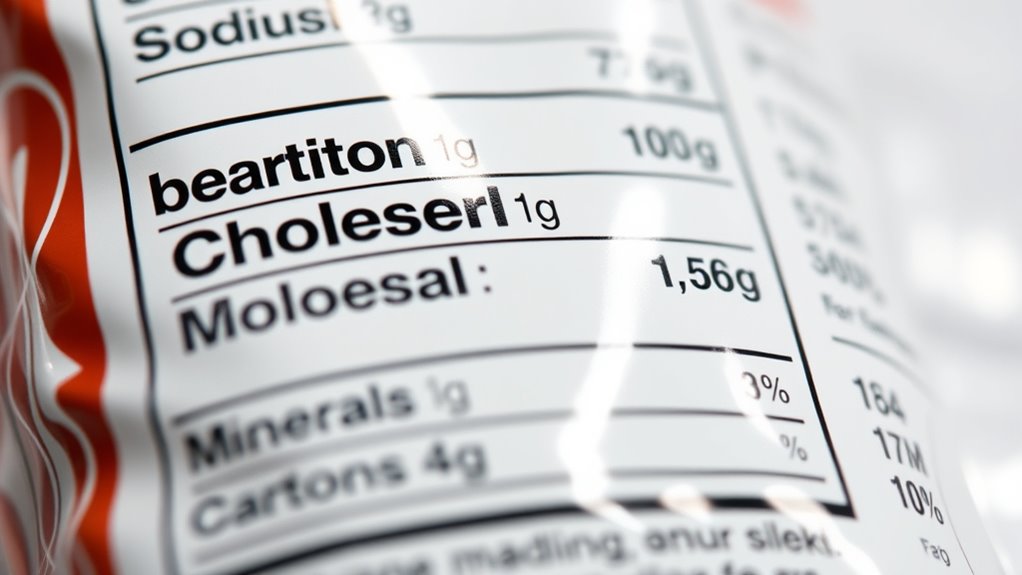
Deciphering sodium, cholesterol, and other minerals on nutrition labels can seem tricky at first, but with a few key tips, you’ll start to see what those numbers really mean for your health. Sodium levels impact your salt intake, which influences blood pressure and fluid balance. Cholesterol numbers help you gauge heart health risks. Other minerals like potassium, calcium, and magnesium support mineral absorption and overall wellness. To visualize:
- High sodium may cause your body to retain water, increasing blood pressure.
- Elevated cholesterol can contribute to artery buildup.
- Minerals like potassium help regulate fluid levels.
- Reading labels helps you balance mineral intake and avoid excessive salt consumption.
Being mindful of these minerals ensures you’re supporting your body’s needs without overdoing it, especially when managing salt intake and optimizing mineral absorption.
Percent Daily Values: How to Use Them
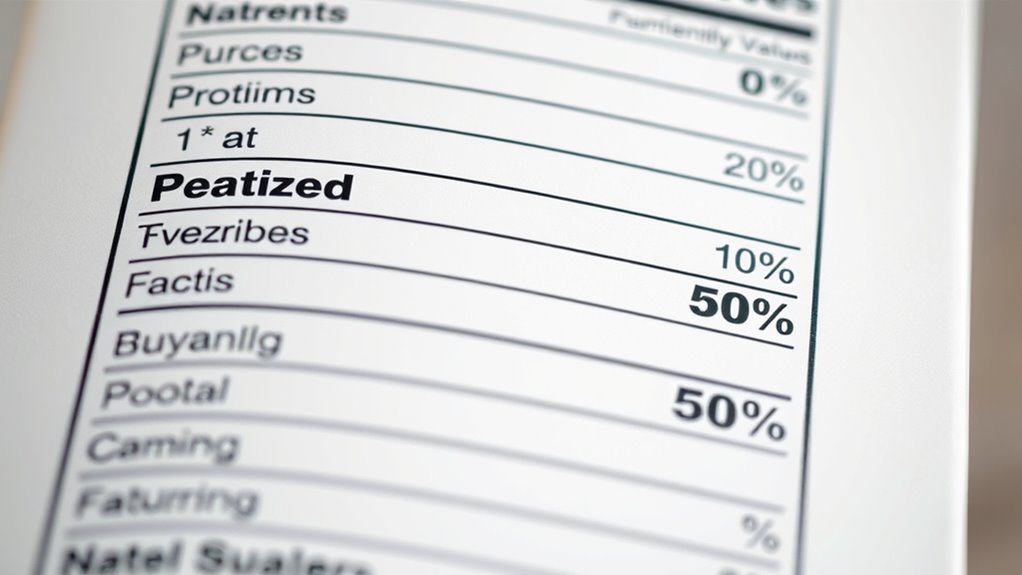
Percent Daily Values (DV) on nutrition labels provide a quick way to understand how a serving of food fits into your daily nutrient needs. To use them effectively, you should understand daily value calculations, which are based on general dietary guidelines. When you see a DV percentage, it indicates how much a nutrient in one serving contributes to your total daily intake. Label interpretation techniques involve comparing these percentages to determine if a food is high or low in a particular nutrient—5% or less is usually low, while 20% or more is high. This allows you to make healthier choices aligned with your nutritional goals. By mastering these methods, you can easily assess the nutritional value of foods and manage your diet more effectively.
Recognizing Unnecessary or Misleading Claims
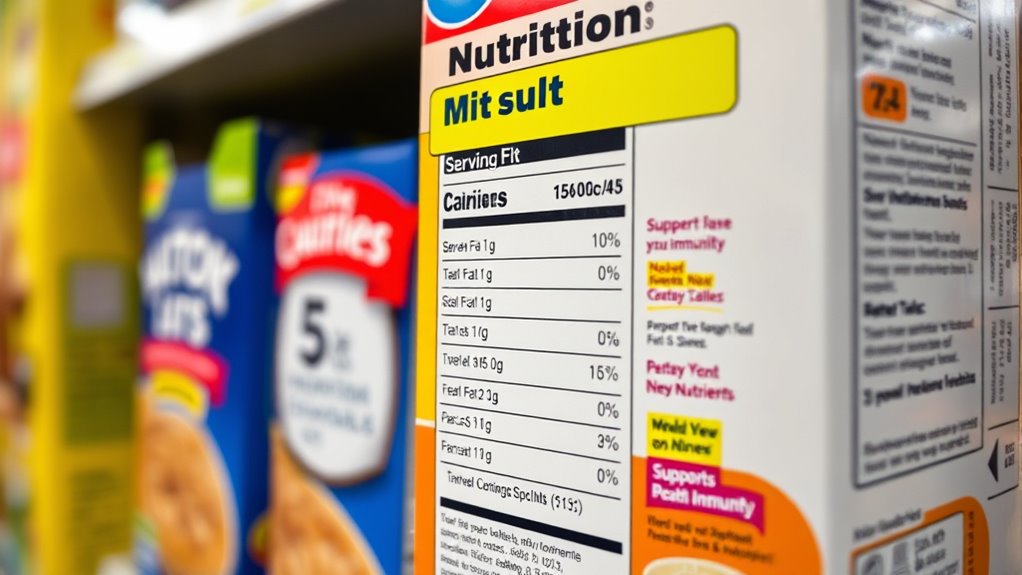
Stores often use health halo claims or marketing tricks to make products seem healthier than they are. You need to be cautious and question claims like “all-natural” or “superfood” that may not be backed by facts. Recognizing these tactics helps you make smarter, more informed choices.
Spotting Health Halo Claims
Have you ever noticed a product boasting “healthy” or “natural” without much explanation? These are common health halo claims used in food marketing to make a product seem better than it really is. To spot these, look beyond the keywords and examine the label closely. Imagine:
- Bright, eye-catching labels that draw attention to one positive feature
- Claims like “gluten-free” or “low-fat” that may not reflect overall nutrition
- Words like “superfood” or “antioxidant-rich” used to boost appeal
- Packaging that emphasizes a single benefit while hiding less healthy ingredients
These tactics can mislead you into thinking a product is healthier than it truly is. Recognizing these health claims helps you make more informed choices and avoid falling for marketing tricks.
Identifying Marketing Tricks
Ever wonder why some food labels seem more appealing than they really are? That’s often due to marketing tricks designed to catch your eye. Companies use clever language, vibrant images, and bold claims to create an illusion of health or quality, leading to label deception. Phrases like “all-natural” or “low-fat” can be misleading if not backed by facts. Remember, marketing tricks aim to distract you from the actual ingredients or nutritional content. Always read the fine print and compare labels carefully. Don’t let eye-catching claims override your judgment. By recognizing these tactics, you can make more informed choices and avoid falling for misleading labels that manipulate your perception of a product’s health benefits.
Tips for Comparing Products Effectively

To compare nutrition labels effectively, you need to look beyond the front packaging and examine the details on the back or side. Focus on the ingredient list to see what’s truly in the product—look for added sugars, preservatives, or unfamiliar additives. Check expiration dates to guarantee freshness and safety. When comparing products, consider these points:
Compare nutrition labels by checking ingredients, serving sizes, calories, and expiration dates for informed choices.
- Ingredient list: Shorter and simpler usually means fewer additives.
- Serving size: Make sure you’re comparing equal portions.
- Calories and nutrients: Look at the calories, fats, sugars, and fiber.
- Expiration date: Ensure the product is fresh and won’t expire soon.
Making Smart Choices Based on Nutrition Labels
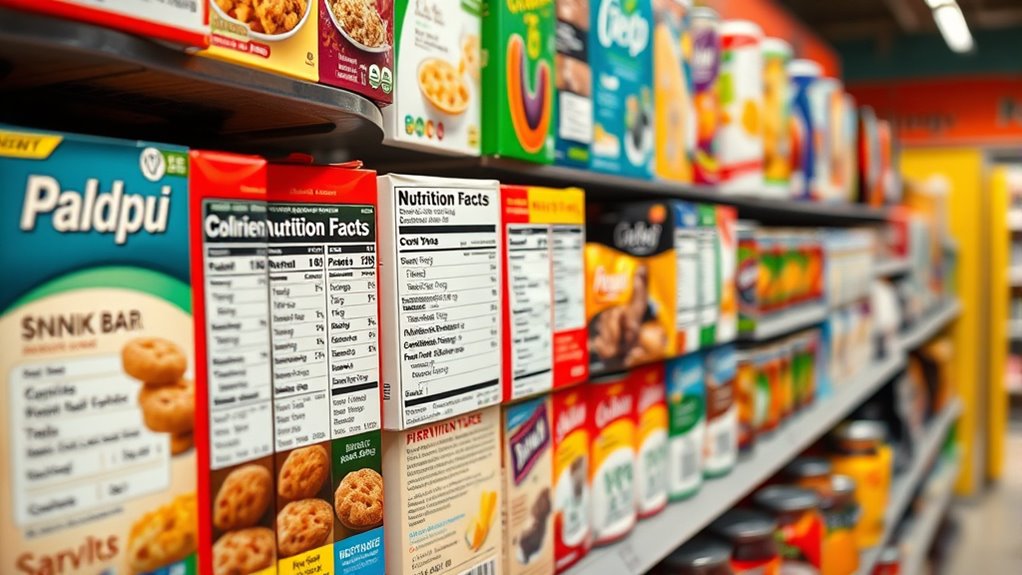
Making smart choices based on nutrition labels involves understanding what the numbers and terms really mean so you can select healthier options. Look beyond calories and fats; check allergy labels to avoid harmful ingredients. Organic certifications indicate products free from synthetic pesticides and GMOs, guiding you toward cleaner choices. Use this table to compare options quickly:
| Nutrient/Label | What to Look For | Why It Matters |
|---|---|---|
| Allergy Labels | Allergens listed clearly | Prevent allergic reactions |
| Organic Certification | USDA Organic logo | Ensures organic standards |
| Sugar Content | Less added sugar | Supports better health |
| Serving Size | Consistent portion size | Accurate calorie count |
Frequently Asked Questions
How Often Should I Check Nutrition Labels When Shopping?
You should check nutrition labels every time you shop, especially if your shopping habits include trying new products or comparing similar items. Regular reading frequency helps you make healthier choices aligned with your dietary goals. Don’t skip this step; it’s a quick habit that guarantees you stay informed about what you’re consuming. Making it a routine will help you develop better eating habits and stay mindful of ingredient and nutrient content.
Are Organic or Natural Labels More Reliable Than Nutrition Labels?
You’re asking if organic or natural labels are more trustworthy than nutrition labels. While organic certifications and natural claims seem promising, they can be misleading—don’t put all your eggs in one basket. Nutrition labels are regulated and provide detailed info on ingredients and nutrients. Relying on both, rather than just one, helps you make more informed choices. Remember, don’t judge a book by its cover; verify the facts.
How Can I Identify Added Sugars on the Nutrition Label?
To identify added sugars on a nutrition label, look at the ingredients list for terms like “sucrose,” “glucose,” or “corn syrup,” which indicate added sugars. Check the “Total Sugars” and “Added Sugars” lines in the nutrition facts; understanding their difference helps with sugar content interpretation. This way, you can make smarter choices by recognizing products with excessive added sugars, supporting a healthier diet.
Do Nutrition Labels Reflect the Actual Portion Sizes I Eat?
Think of nutrition labels as a map, guiding you through a landscape of ingredients. While they aim for portion accuracy, they can sometimes be like a mirage—showing ideal amounts that don’t match your actual eating habits. Label consistency varies between products, so your portions might not align perfectly. Always measure your servings and compare them to the label to verify you’re truly aware of what you’re consuming.
How Do I Interpret Allergens and Ingredient Lists Alongside Nutrition Labels?
When reading allergens and ingredient lists, you should look for potential allergen cross contact warnings and check ingredient sourcing to understand how products are made. Allergens are often highlighted or listed separately, so pay close attention. Ingredient sourcing can reveal quality or origin concerns. By carefully reviewing these sections, you can make informed choices, avoid allergens, and understand more about what’s in your food.
Conclusion
By mastering nutrition labels, you hold the key to making smarter food choices. Think of them as your map through a sea of options, guiding you toward healthier habits. With each label you read, you build confidence and clarity, turning confusing information into a clear pathway. So, embrace these labels like a trusted compass—navigating your journey to better health with every informed decision you make.

